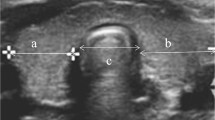Abstract
Objective: To gain an insight into risk factors for hypothyroidism after subacute thyroiditis (SAT), we examined the correlation between initial laboratory and ultrasonographic findings and sequential thyroid dysfunction among treatment modalities. Patients: We reviewed retrospectively the medical records of 252 patients (26 men and 226 women) with SAT who consecutively visited our thyroid clinic at Kuma Hospital for at least 6 months from 1996 through 2004. Results: Throughout the course, 135 patients (53.6%) developed transient or permanent hypothyroidism. Levels of TSH were most often elevated (greater than 5 IU/ml) 2 months after SAT onset regardless of treatment, and 97.0% of patients who showed transient or permanent hypothyroidism clustered within 6 months from onset. During follow-up, patients treated with prednisone (PSL) were more likely to have normal thyroid function than patients not treated or those receiving anti-inflammatory drug therapy. In patients who developed hypothyroidism with PSL treatment or without treatment, the rates of bilateral hypoechogenic areas (HEA) were 6-fold higher than those of unilateral HEA. Moreover, permanent hypothyroidism occurred in 5.9% of patients, and all patients with permanent hypothyroidism presented initially with bilateral HEA and had consequently small thyroid size with or without abnormal autoimmunity. Conclusions: The rates of thyroid dysfunction after SAT were significantly lower in patients receiving PSL. Extent of HEA in the thyroid, but not laboratory findings, may be a possible marker for developing thyroid dysfunction after SAT.
Similar content being viewed by others
References
Farwell AP. Subacute thyroiditis and acute infectious thyroiditis. In: Braverman LE, Utiger RD eds. The Thyroid. A Fundemental and Clinical Text. Ninth edition. Philadelphia: Lippincott Williams & Wilkins (LWW). 2005, 536.
Lio S, Pontecorvi A, Caruso M, Monaco F, D’Armiento M. Transitory subclinical and permanent hypothyroidism in the course of subacute thyroiditis (de Quervain). Acta Endocrinol (Copenh) 1984, 106: 67–70.
Fatourechi V, Aniszewski JP, Fatourechi GZ, Atkinson EJ, Jacobsen SJ. Clinical features and outcome of subacute thyroiditis in an incidence cohort: Olmsted County, Minnesota, study. J Clin Endocrinol Metab 2003, 88: 2100–5.
Cordray JP, Nys P, Merceron RE, Augusti A. Frequency of hypothyroidism after De Quervain thyroiditis and contribution of ultrasonographic thyroid volume measurement. Ann Med Interne (Paris) 2001, 152: 84–8.
Benbassat CA, Olchovsky D, Tsvetov G, Shimon I. Subacute thyroiditis: clinical characteristics and treatment outcome in fifty-six consecutive patients diagnosed between 1999 and 2005. J Endocrinol Invest 2007, 30: 631–5.
Erdem N, Erdogan M, Ozbek M, et al. Demographic and clinical features of patients with subacute thyroiditis: results of 169 patients from a single university center in Turkey. J Endocrinol Invest 2007, 30: 546–50.
Volpé R, Row VV, Ezrin C. Circulating viral and thyroid antibodies in subacute thyroiditis. J Clin Endocrinol Metab 1967, 27: 1275–84.
Strakosch CR, Joyner D, Wall JR. Thyroid-stimulating antibodies in patients with subacute thyroiditis. J Clin Endocrinol Metab 1978, 46: 345–8.
Bennedbaek FN, Hegedüs L. The value of ultrasonography in the diagnosis and follow-up of subacute thyroiditis. Thyroid 1997, 7: 45–50.
Park SY, Kim EK, Kim MJ, et al. Ultrasonographic characteristics of subacute granulomatous thyroiditis. Korean J Radiol 2006, 7: 229–34.
Nishihara E, Ohye H, Amino N, Takata K, Arishima T, Kudo T, Ito M, Kubota S, Fukata S, Miyauchi A. Clinical characteristics of 852 patients with subacute thyroiditis before treatment. Intern Med 2008, 47: 725–9.
Marcocci C, Vitti P, Cetani F, Catalano F, Concetti R, Pinchera A. Thyroid ultrasonography helps to identify patients with diffuse lymphocytic thyroiditis who are prone to develop hypothyroidism. J Clin Endocrinol Metab 1991, 72: 209–13.
Ota H, Amino N, Morita S, et al. Quantitative measurement of thyroid blood flow for differentiation of painless thyroiditis from Graves’ disease. Clin Endocrinol (Oxf) 2007, 67: 41–5.
Kasagi K. Painful Hashimoto’s thyroiditis. Intern Med 2006, 45: 351–2.
Ohye H, Nishihara E, Sasaki I, Kubota S, Fukata S, Amino N, Kuma K, Miyauchi A. Four cases of Graves’ disease which developed after painful Hashimoto’s thyroiditis. Intern Med 2006, 45: 385–9.
Werner SC. Graves’ disease following acute (subacute) thyroiditis. Arch Intern Med 1979, 139: 1313–5.
Wartofsky L, Schaaf M. Graves’ disease with thyrotoxicosis following subacute thyroiditis. Am J Med 1987, 83: 761–4.
Fukata S, Matsuzuka F, Kobayashi A, Hirai K, Kuma K, Sugawara M. Development of Graves’ disease after subacute thyroiditis: two unusual cases. Acta Endocrinol (Copenh) 1992, 126: 495–6.
Bartalena L, Bogazzi F, Pecori F, Martino E. Graves’ disease occurring after subacute thyroiditis: report of a case and review of the literature. Thyroid 1996, 6: 345–8.
Grunenberger F, Chenard MP, Weber JC, Jaeck D, Schlienger JL. Relapse of Graves’ disease after subacute thyroiditis. Thyroid 1998, 8: 683–5.
Iitaka M, Kakinuma S, Yamanaka K, et al. Induction of autoimmune hypothyroidism and subsequent hyperthyroidism by TSH receptor antibodies following subacute thyroiditis: a case report. Endocr J 2001, 48: 139–42.
Tamai H, Nozaki T, Mukuta T, et al. The incidence of thyroid stimulating blocking antibodies during the hypothyroid phase in patients with subacute thyroiditis. J Clin Endocrinol Metab 1991, 73: 245–50.
Iitaka M, Momotani N, Hisaoka T, et al. TSH receptor antibody-associated thyroid dysfunction following subacute thyroiditis. Clin Endocrinol (Oxf) 1998, 48: 445–53.
Nishihara E, Fukata S, Kimura N, et al. A case of hypothyroid Graves’ disease following external radiation therapy to the cervical region. Endocr J 2006, 53: 357–61.
Yamada T, Sato A, Aizawa T. Dissociation between serum interleukin-6 rise and other parameters of disease activity in subacute thyroiditis during treatment with corticosteroid. J Clin Endocrinol Metab 1996, 81: 577–9.
Nishihara E, Hirokawa M, Ohye H, et al. Papillary carcinoma obscured by complication with subacute thyroiditis: sequential ultrasonographic and histopathological findings in five cases. Thyroid 2008, 18: 1221–5.
Author information
Authors and Affiliations
Corresponding author
Rights and permissions
About this article
Cite this article
Nishihara, E., Amino, N., Ohye, H. et al. Extent of hypoechogenic area in the thyroid is related with thyroid dysfunction after subacute thyroiditis. J Endocrinol Invest 32, 33–36 (2009). https://doi.org/10.1007/BF03345675
Accepted:
Published:
Issue Date:
DOI: https://doi.org/10.1007/BF03345675




